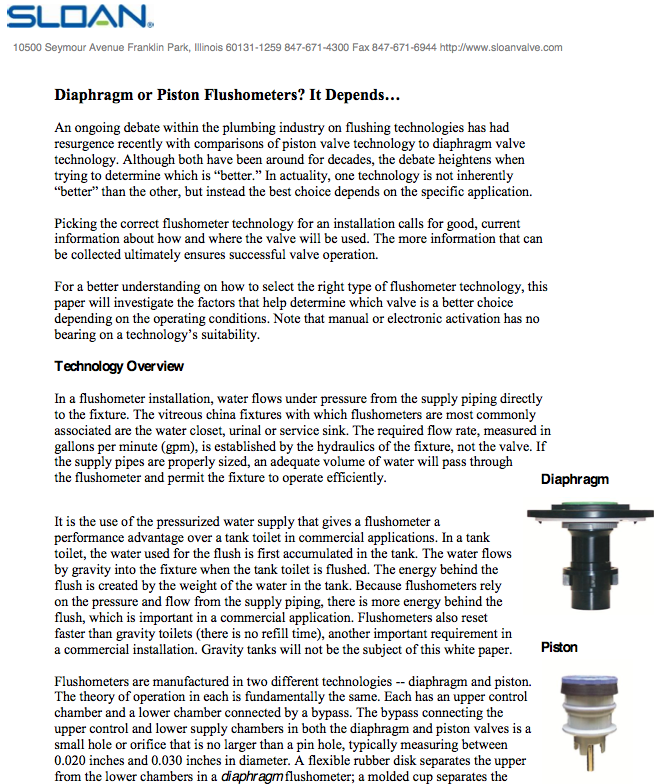How do you know when to choose diaphragm vs. piston flushometer valve technology? Sloan has issued a new white paper that discusses the differences between diaphragm and piston valve flushing technologies and includes charts that show under which operating conditions to specify one type over the other.
“Diaphragm and piston flush valves each have their strengths and are best suited for different environmental conditions,” says Mike Gipson, Flushometer Product Line Manager for Sloan. “It’s important to assess the environment before choosing to install diaphragm or piston technology.”
In addition to illustrating the mechanical differences between diaphragm and piston flushometers, the white paper highlights considerations that impact which type of technology is most appropriate for various restroom environments, including:
- High or low restroom traffic
- Water quality, including the pH of the water and chlorine concentration
- Operating conditions, such as high or low water pressure systems
Sloan invented the diaphragm flush valve more than 100 years ago and then introduced piston valves about 20 years later. Today, Sloan manufactures both diaphragm and piston flush valves in sensor-activated and manual models. Diaphragm flushometers include the Royal, UPPERCUT, Regal XL and Sloan brand valves; the Crown and GEM•2 valves are piston operated. Sloan offers flushometers for every type of environment from normal restroom applications to extremely harsh water conditions.
To help you determine which type of flushometer valve is best suited for the variety of restroom environments, download a PDF of the “Diaphragm or Piston Flushometers? It Depends...” white paper at http://www.sloanvalve.com/Water_Efficiency/SLV3583-Diaphragm_Piston_White-Paper.pdf. BD+C
Related Stories
| Jan 13, 2014
Custom exterior fabricator A. Zahner unveils free façade design software for architects
The web-based tool uses the company's factory floor like "a massive rapid prototype machine,” allowing designers to manipulate designs on the fly based on cost and other factors, according to CEO/President Bill Zahner.
| Jan 13, 2014
AEC professionals weigh in on school security
An exclusive survey reveals that Building Teams are doing their part to make the nation’s schools safer in the aftermath of the Sandy Hook tragedy.
| Jan 13, 2014
6 legislative actions to ignite the construction economy
The American Institute of Architects announced its “punch list” for Congress that, if completed, will ignite the construction economy by spurring much needed improvements in energy efficiency, infrastructure, and resiliency, and create jobs for small business.
| Jan 12, 2014
CES showcases innovations: Can any of these help you do your job better?
The Consumer Electronics Show took place this past week in Las Vegas. Known for launching new products and technologies, many of the products showcased there set the bar for future innovators. The show also signals trends to watch in technology applicable to the design and building industry.
| Jan 12, 2014
The ‘fuzz factor’ in engineering: when continuous improvement is neither
The biggest threat to human life in a building isn’t the potential of natural disasters, but the threat of human error. I believe it’s a reality that increases in probability every time a code or standard change is proposed.
| Jan 12, 2014
5 ways virtual modeling can improve facilities management
Improved space management, streamlined maintenance, and economical retrofits are among the ways building owners and facility managers can benefit from building information modeling.
| Jan 11, 2014
Getting to net-zero energy with brick masonry construction [AIA course]
When targeting net-zero energy performance, AEC professionals are advised to tackle energy demand first. This AIA course covers brick masonry's role in reducing energy consumption in buildings.
| Jan 10, 2014
What the states should do to prevent more school shootings
To tell the truth, I didn’t want to write about the terrible events of December 14, 2012, when 20 children and six adults were gunned down at Sandy Hook Elementary School in Newtown, Conn. I figured other media would provide ample coverage, and anything we did would look cheap or inappropriate. But two things turned me around.
| Jan 10, 2014
Special Report: K-12 school security in the wake of Sandy Hook
BD+C's exclusive five-part report on K-12 school security offers proven design advice, technology recommendations, and thoughtful commentary on how Building Teams can help school districts prevent, or at least mitigate, a Sandy Hook on their turf.
| Jan 10, 2014
Resiliency, material health among top AEC focuses for 2014: Perkins+Will survey
Architectural giant Perkins+Will recently surveyed its staff of 1,500 design pros to forcast hot trends in the AEC field for 2014. The resulting Design + Insights Survey reflects a global perspective.

















